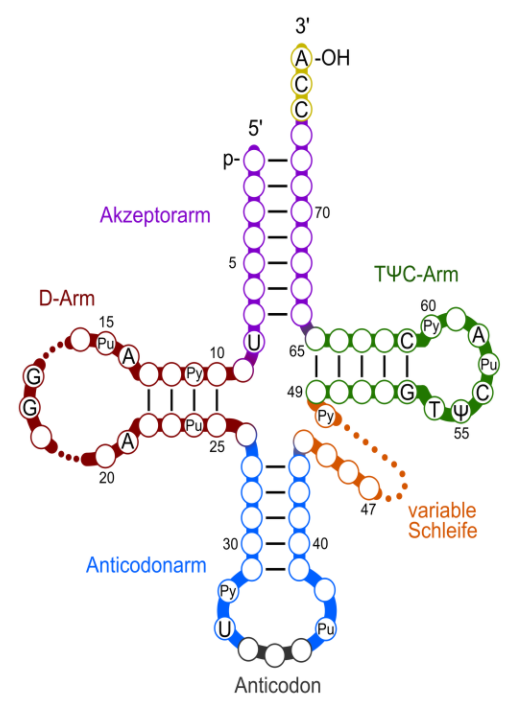
Who suggested the clover leaf model of the tRNA?
A) Went
B) Flemming
C) Holley
D) Messelson
Answer
494.4k+ views
1 likes
Hint: American biochemist, assumes the clover leaf like structure of tRNA in 1965 due to the concept of folding of the single stranded tRNA. He shared the Nobel Prize in Physiology or Medicine in 1968 with Marshall Warren Nirenberg and Har Gobind Khorana.
Complete Answer:
- Robert William Holley was an American biochemist. He shared the Nobel Prize in Physiology or Medicine in 1968.
- He described the structure of alanine transfer RNA, linking DNA and protein synthesis. Their research helped to explain the role of genetic code in controlling the synthesis of proteins. They demonstrated the role of tRNAs (a specific type of ribonucleic acids) in the assembly of amino acids into proteins.
- Holley along with his collaborators worked to develop separation techniques which isolate the different transfer RNAs.

Additional Information:
- Due to the distinctive folded structure with three hairpin loops the tRNA molecule has a shape of a three-leafed clover form.
- Anticodon sequences are present in one these hairpin loops which can recognize and decode an mRNA codon.
- Each tRNA has specific anticodons present on the Anticodon loop and thus have specific corresponding amino acids, and that’s how specific tRNA searches its corresponding Amino acid and gets attached to its end.
Note: The American biologist Paul C. Zamecnik and Mahlon Hoagland discovered tRNA in 1956. The Dutch biologist Frits Warmolt Went demonstrated the existence of auxin in plants in an experiment in 1928. Alexander Fleming was a Scottish physician-scientist who discovered penicillin. Matthew Stanley Meselson is a geneticist and molecular biologist currently at Harvard University, known for his demonstration, with Franklin Stahl, of semi-conservative DNA replication.
Complete Answer:
- Robert William Holley was an American biochemist. He shared the Nobel Prize in Physiology or Medicine in 1968.
- He described the structure of alanine transfer RNA, linking DNA and protein synthesis. Their research helped to explain the role of genetic code in controlling the synthesis of proteins. They demonstrated the role of tRNAs (a specific type of ribonucleic acids) in the assembly of amino acids into proteins.
- Holley along with his collaborators worked to develop separation techniques which isolate the different transfer RNAs.

Additional Information:
- Due to the distinctive folded structure with three hairpin loops the tRNA molecule has a shape of a three-leafed clover form.
- Anticodon sequences are present in one these hairpin loops which can recognize and decode an mRNA codon.
- Each tRNA has specific anticodons present on the Anticodon loop and thus have specific corresponding amino acids, and that’s how specific tRNA searches its corresponding Amino acid and gets attached to its end.
Note: The American biologist Paul C. Zamecnik and Mahlon Hoagland discovered tRNA in 1956. The Dutch biologist Frits Warmolt Went demonstrated the existence of auxin in plants in an experiment in 1928. Alexander Fleming was a Scottish physician-scientist who discovered penicillin. Matthew Stanley Meselson is a geneticist and molecular biologist currently at Harvard University, known for his demonstration, with Franklin Stahl, of semi-conservative DNA replication.
Recently Updated Pages
Express the following as a fraction and simplify a class 7 maths CBSE

The length and width of a rectangle are in ratio of class 7 maths CBSE

The ratio of the income to the expenditure of a family class 7 maths CBSE

How do you write 025 million in scientific notatio class 7 maths CBSE

How do you convert 295 meters per second to kilometers class 7 maths CBSE

Write the following in Roman numerals 25819 class 7 maths CBSE

Trending doubts
Give 10 examples of unisexual and bisexual flowers

Draw a labelled sketch of the human eye class 12 physics CBSE

Differentiate between homogeneous and heterogeneous class 12 chemistry CBSE

Differentiate between insitu conservation and exsitu class 12 biology CBSE

What are the major means of transport Explain each class 12 social science CBSE

Franz thinks Will they make them sing in German even class 12 english CBSE




